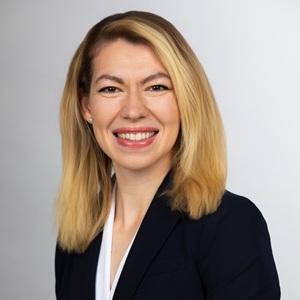As an undergraduate, Alex Pedowitz wanted to become a physician, but also felt driven to tackle societal issues that affected the health of patients.
“I am a systemic-level thinker,” Pedowitz says. “I want to know what is going on with the patient in front of me, but also, why? What causes a pathology? How do I prevent it?”
Pedowitz now follows both ambitions at the University of Miami Miller School of Medicine, where she is pursuing degrees in medicine (MD) and public health (MPH).

Alex Pedowitz
“This gives me the best exposure to serving different populations, learning about what causes health care disparities, and what I can do about it,” says Pedowitz, entering her fourth year of medical school.
Pedowitz is among a growing number of students who are pursuing another type of graduate degree alongside their MD. About 9% of medical students pursue dual degrees, according to enrollment data compiled by the AAMC. Enrollment numbers over time are not publicly available for all dual degree programs, but many schools report increasing enrollments in second-degree offerings over the past 10 to 15 years.
For example:
- A study of selected medical schools, led by the Keck School of Medicine of the University of Southern California, found a 434% increase in the number of students pursuing dual MD-MPH degrees from 2010 to 2018.
- At the Mayo Clinic Alix School of Medicine, Melanie Bois, MD, director of enrichment at the Minnesota campus, reports that about 16% of its students are enrolled in dual degree programs, which is well above the national average.
- At the Miller School of Medicine, Gauri Agarwal, MD, associate dean of curriculum, says that enrollment in its master of business administration (MBA) dual degree program has tripled in recent years, to as many as 30 MD-MBA students in each class.
At the same time, medical schools have been adding dual degree opportunities, both in traditional areas (PhD, MBA, MPH) and in other disciplines. Depending on the school they choose, students can pursue dual degrees in medicine and health informatics, artificial intelligence, health care administration, mass communication, international administration, and a host of sciences, such as biomedicine.
Administrators say student interest in dual degrees is increasing because of growing complexities in health care, the business of providing it, and health policy.
“Students understand that medicine should also encompass learning about health systems, about the social determinants of health, about technologies that affect medicine,” says Stephanie Gutierrez, MEd, manager of dual degree programs at the Joe R. and Teresa Lozano Long School of Medicine at The University of Texas Health Science Center at San Antonio.
“Our health care system is so incredibly complex, and having a financial knowledge, public health knowledge, or research knowledge gives you a leg up” in building a career, says Agarwal at the Miller School of Medicine.
Schools increasingly feel a need to respond to that desire for cross-disciplinary learning.
“Our students are telling us, ‘We want these types of programs to support our journeys through medicine,’” Gutierrez says. “You need to be offering dual degrees because you want to be competitive with other schools.”
Students see career benefits
When a medical school applicant or potential applicant expresses an interest in getting a dual degree, those who oversee those programs press the student to think about why.
“We want to make sure they’re doing it for the right reasons, that they have a plan for what they’re going to do with that other degree in the future,” says Monica Harbell, MD, director of enrichment at the Mayo Clinic Alix School of Medicine, Arizona campus. “They should not be doing it just to add more letters” — that is, academic credentials, after their names.
Salila Kurra, MD, associate dean for student career development at Columbia University Vagelos College of Physicians and Surgeons, gives an example: “If you want to be a practicing surgeon, I would ask you, ‘Why are you thinking about getting an MBA or an MPH? Where do you see yourself in the future? You need a coherent 10- or 15-year plan’” for how the two degrees will shape your career.
Sometimes those conversations lead a student to decide against the second degree, says Monica Lypson, MD, MPH, vice dean for medical education at the Vagelos College of Physicians and Surgeons. In other cases, the conversations help students and school leaders craft a customized educational experience.
“We’re seeing students who are highly focused,” says Bois at the Mayo Clinic Alix School of Medicine. “Students are coming in and saying, ‘I want to do this specialty, and within that specialty I want to focus in this area. I think an MPH partnered with this type of curriculum is going to accelerate my career pathway and get me to where I want to go.’”
For MD-PhD students, the path is usually clear: They want to become researchers and teachers in addition to practicing medicine. (This paper looks at the range of fields for MD-PhD students.)
Those seeking MBAs are typically interested in improving how health care systems run. “They’re thinking that they can use what they learned in business school to make health care more efficient,” says Harbell at the Mayo Clinic Arizona, where several of the dual degrees are offered in partnership with Arizona State University.
That could be in their own practice, but “a lot of them want to be in leadership positions, maybe CEO of a health system,” says Agarwal.
In conversations with student considering dual degrees, Gutierrez asks, “Do you see yourself as chief medical officer or a department chief? Then it’s important to develop additional expert-level knowledge, such as making budgets, working with human resources, and developing leadership to oversee staff. This is where the dual degree is appropriate.”
As for those who pursue MPH degrees, such as Pedowitz, a common motivation is the desire to understand systemic inequities at the population level and to work for system and policy changes. They might become health commissioners or launch campaigns to address a specific health cause.
“We talk about how you would understand social determinants of health, epidemiology, the environmental causes of disease,” Gutierrez says.
A lot of students pursue a second degree in hopes of improving their credentials for their preferred residency matches. Opinions are divided as to whether a dual degree helps in that regard.
“It demonstrates that this is a very driven student, an accomplished individual,” says Ron Ben-Ari, MD, senior associate dean for medical education at the Keck School of Medicine. “But I expect that other things tend to be more attractive to a residency program, like if a student has done a lot of scholarship. Because it is less clear how you are going to apply the MBA in the residency.”
One comparison of match outcomes between traditional medical degree and dual degree applicants found that “despite the growing popularity of combined MD programs, such programs do not appear to increase applicant match competitivity.” (The authors note several limitations to their study, including that the database they drew from for their analysis “does not account for whether these secondary degrees were obtained before, concurrent to, or after an MD curriculum.”)
How students make it work
Schools have tried a variety of ways to ease the extra burden on students seeking these dual advanced degrees.
One common structure is for students to take a year off from medical school — typically after their third year — to earn their selected master’s degree, then return to medical school for their final year. That’s how it works for students at the Keck School of Medicine, with some overlapping credits for both degrees and, for the MBA, some overlapping time in the fall of the students’ final year because this degree takes a bit longer to complete, Ben-Ari says.
At the Joe R. and Teresa Lozano Long School of Medicine, however, students integrate their work on an MPH within their medical school schedule, Gutierrez says. They begin MPH classes in the summer before medical school starts, then pick up those MPH studies alongside their medical school curriculum and during breaks in the medical school schedule, such as other summers.
At the Miller School of Medicine, Pedowitz will complete her MD and MPH in four years, rather than the five years that is typical of MD-MPH programs. At the Vagelos College of Physicians and Surgeons, some of the credits that students earn in medical school can count toward their MPH, Lypson says. While the MPH is a two-year degree, the sharing of credits allows medical students to take just one extra year to complete the MPH.
At the Mayo Clinic Alix School of Medicine, students getting an MS in management take those classes online through Northeastern University while they continue their medical degrees, Harbell says.
Schools see a growing need
Why do schools develop new programs and devise ways to accommodate dual degree students? A study of 19 schools that provide MD-master’s degree programs, published in 2024, found that the top reasons include expanding student skill sets beyond a medical degree, fostering interdisciplinary collaboration, expanding career goals, developing leaders, and furthering the institution’s mission.
“These programs provide students with opportunities for additional areas of expertise, leadership development, enhancement of competitiveness for residency application, and interdisciplinary collaboration,” the study notes.
An added benefit: Administrators say that some prospective students are drawn by the opportunity to pursue a second degree.
“It’s a huge recruiting tool for us, because we stand out in that way,” says Gutierrez.
The development of dual degree programs has expanded enough that several schools created, in 2023, the Medical Education Dual Degree Consortium. Gutierrez, the founding chair, said the group is looking to consolidate a summary of existing programs and explore issues such as support for students and the impacts of the programs. (A similar, existing group focuses on MD-PhD programs: GREAT MD-PhD Section Forum.)
At the Miller School of Medicine, Pedowitz envisions where she’s going with her dual MD-MPH degree while focusing on emergency medicine:
“I see myself in a clinical environment that’s really intense. From a public health perspective, I see myself in advocacy and leadership and education, taking patient stories and stories from my colleagues, and thinking, ‘What’s lacking in the field of medicine? What’s lacking in the field of public health? How can I use my knowledge to push for change?’
“I see myself using research, networking, and talking to people to adapt our systems and make them better.”

